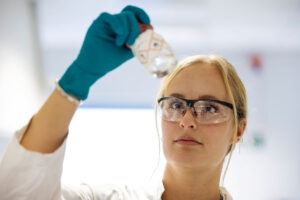An overview of BKC 0.13%
Benzalkonium Chloride (BKC) is a well-established quaternary ammonium compound widely recognized for its broad-spectrum antimicrobial efficacy. In its 0.13% solution, BKC occupies a critical niche in healthcare and personal care applications—delivering potent microbial control while maintaining a favourable safety profile for topical and mucosal use.
This specific concentration offers an ideal balance between effectiveness and tolerability. It is commonly used in pharmaceutical products, including dermatological cleansers, wound care solutions, and mucosal antiseptics, where both antimicrobial reliability and patient comfort are essential. While lower concentrations can be just as effective, 0.1-0.13% is stated in the US FDA OTC (Over-the-Counter) monograph M003 for first aid antiseptic drugs, thus used a reference for a multitude of marketed antiseptic products.
BKC acts as a cationic surfactant, disrupting microbial membranes by interacting with negatively charged phospholipids. This leads to membrane destabilization, leakage of cellular contents, and rapid cell lysis. Because this mode of action targets the physical structure of pathogens rather than metabolic pathways—it does not trigger resistance, a key benefit over traditional antibiotics.
As antibiotic resistance becomes a growing global concern, BKC continues to serve as a reliable component in infection control. Its non-antibiotic mechanism, broad application range, and established safety make it a cornerstone active ingredient in both over-the-counter and prescription-grade antiseptic prepaprations.
Why 0.13% matters in practice
BKC is used across a range of concentrations, but 0.13% is widely recognized as a key benchmark in antiseptics—offering robust antimicrobial efficacy while remaining well tolerated in topical and mucosal applications. Its adoption across regulated healthcare products reflects both clinical validation and formulation practicality.
This concentration is ideal for use as an active in:
- Dermatologic cleansers for acne and eczema
- Wound cleaning and antiseptic wipes
- Mucosal sprays and rinses
As demand increases for alcohol-free, broad-spectrum antiseptics, BKC 0.13% stands out as a proven choice for modern therapeutic and hygiene products.

Application in acne treatment
Acne vulgaris is a chronic inflammatory skin disorder marked by the obstruction and inflammation of pilosebaceous units. It is largely driven by factors such as sebaceous hyperactivity, keratinocyte proliferation, and microbial colonization, particularly by Cutibacterium acnes. The control of microbial overgrowth and prevention of secondary infections are key therapeutic targets, and BKC 0.13% offers a compelling antiseptic approach within this context.
Topical antibiotics such as clindamycin and erythromycin have long been used in acne therapy, but their efficacy is increasingly challenged by antibiotic resistance. BKC 0.13% as well as lower concentrations, presents a non-antibiotic antimicrobial alternative with broad-spectrum efficacy and minimal risk of resistance development. It acts rapidly on Gram-positive bacteria, including C. acnes, without engaging bacterial protein synthesis or DNA replication pathways.
Use in dermatological cleansers and adjunctive care
BKC 0.13% is commonly formulated into:
- Antiseptic facial cleansers that help reduce microbial load on acne-prone skin.
- Pre- and post-procedural wipes and solutions used in connection with treatments like microneedling, chemical peels, or laser therapy to prevent infection and support wound healing.
- Combination formulations that pair BKC with keratolytics such as salicylic acid or niacinamide for enhanced therapeutic effect.
In clinical and cosmetic dermatology, the inclusion of BKC ensures both hygiene and protection, especially when skin is compromised by inflammation or interventional treatments.
Tolerability and patient compliance
At the 0.13% concentration, BKC is generally well tolerated in non-sensitive individuals. It offers a low-odour, non-stinging, and alcohol-free option, making it suitable for patients with sensitive or oily skin types. Its ease of incorporation into daily routines supports better compliance compared to more aggressive or drying agents like benzoyl peroxide.
Consult our white paper on targeting acne with Benzalkonium Chloride:

Application in eczema management
Atopic dermatitis (eczema) is a chronic inflammatory skin condition characterized by skin barrier dysfunction, immune dysregulation, and frequent secondary bacterial colonization, particularly by Staphylococcus aureus. This colonization not only exacerbates inflammation but also increases the risk of infection during flare-ups. Here, BKC 0.13% plays a valuable role as a topical antiseptic in eczema care regimens.
Studies have shown that over 90% of atopic dermatitis lesions are colonized by S. aureus. BKC’s ability to disrupt bacterial membranes including multi-resistant S. aureus (MRSA) and reduce microbial load directly correlates with fewer infections, reduced inflammation, and shortened flare durations. It offers a non-antibiotic method to manage microbial imbalances without contributing to antimicrobial resistance.
Application formats in eczema care
BKC 0.13% is commonly formulated into:
- Non-soap-based cleansers designed for daily use on sensitive skin.
- Antimicrobial bath additives used in therapeutic soak treatments.
- Wet wrap therapy: As part of a regimen where medicated or emollient-soaked bandages are applied over skin treated with BKC to provide intensive hydration and bacterial control.
- Leave-on formulations: Low-residue gels or creams for targeted use during flare-ups.
Considerations for sensitive skin
While effective, the use of any antimicrobial in eczema must consider the delicate nature of the compromised skin barrier. BKC 0.13% formulations are typically pH-balanced and fragrance-free to minimize irritation risk. Its non-drying profile, particularly in emollient-rich bases, supports skin barrier restoration while maintaining antiseptic integrity. Developing formulations with lower BKC concentrations can also be recommended.
Broader applications and therapeutic areas
Beyond its dermatologic uses, Benzalkonium Chloride (BKC) 0.13% has broad utility across several healthcare and pharmaceutical contexts. Its antimicrobial profile, formulation flexibility, and safety at defined concentrations make it an ideal active or preservative in a variety of clinical and consumer products.
Wound care and minor surgical applications
BKC is widely used in wound irrigation solutions, antiseptic sprays, and moist towelettes for first aid and surgical site preparation. At 0.13%, it provides effective control against a spectrum of skin and wound pathogens, including Staphylococcus aureus, Pseudomonas aeruginosa, and various anaerobes.
It is especially useful where alcohol-based solutions are not desirable due to stinging, drying, or flammability risks. Its inclusion in post-operative care kits and chronic wound dressings supports infection prevention and promotes a cleaner healing environment without disrupting tissue integrity. 0.13% Benzalkonium chloride soaks are also an established treatment against hydrofluoric acid (HF) burns on the skin.
Ophthalmic, nasal and otic preparations
BKC has long been employed as a preservative in eye drops and nasal solutions. At low concentrations ranging typically from 0.001 to 0.01%, it prevents microbial contamination in multi-dose containers, extending shelf life and ensuring sterility. While there is some debate regarding long-term ocular exposure—particularly in patients with glaucoma or dry eye syndrome—its continued use in short-term ophthalmic formulations remains common.
Similarly, BKC in low concentrations serves as an antimicrobial in otic (ear) preparations, particularly for external ear infections, where its action helps control bacterial and fungal pathogens.
Mucosal and oral applications
BKC 0.13% is used as an active in nasal sprays, mouthwashes, and throat lozenges, particularly in cold and flu preparations. Its role in inactivating enveloped viruses and reducing bacterial colonization on mucosal surfaces makes it valuable for infection prevention and symptomatic relief. In these applications, BKC acts quickly and is typically used in formulations designed for short-term use to mitigate potential mucosal sensitivity.
Hygiene and surface disinfection
In hospital and clinical settings, BKC 0.13% is an effective ingredient in hand sanitizers, surface disinfectants, and medical device cleaners. While alcohol remains a gold standard in many disinfection protocols, BKC provides a non-flammable, longer-lasting alternative with residual activity. It is also less drying to the skin, supporting more frequent use without the adverse effects commonly associated with high-alcohol formulations.
Its utility in pre-operative hand scrubs, instrument sanitizing solutions, and patient-contact surfaces highlights its contribution to infection control workflows in healthcare environments.
It also plays a role in women’s hygiene products such as washes, gels and creams, often for its anti-fungal properties.
Formulation considerations
Incorporating Benzalkonium Chloride (BKC) 0.13% into pharmaceutical, personal care, or medical formulations requires a clear understanding of its chemical characteristics and performance behaviour. While BKC is highly effective as an antimicrobial, its efficacy and safety depend significantly on how it is formulated and delivered.
Stability and pH sensitivity
BKC exhibits antimicrobial activity over the entire pH range, with its activity increasing as the pH rises. Formulators must avoid or counteract the mixing of BKC in the presence anionic compounds or compounds with which it can form a precipitate.
BKC is both temperature and light resistant, providing manufacturing process flexibility and as a preservative, prolonged product shelf life.
Compatibility with excipients
BKC is a cationic surfactant, which means it can interact with anionic compounds, leading to precipitation or loss of antimicrobial activity. Common formulation conflicts include:
- Anionic surfactants (e.g., sodium lauryl sulphate)
- Certain thickeners and emulsifiers (e.g. Tween, lecithin)
- Natural polysaccharides with acidic groups (e.g. xanthan gum, pectin)
To avoid these incompatibilities, formulators often pair BKC with non-ionic or amphoteric excipients, ensuring both physical stability and microbial efficacy. Some excipients can also enhance the effect of BKC, such as chelators (e.g. EDTA) and other quaternary ammonium compounds.
Formulation formats and delivery systems
BKC 0.13% is highly adaptable and can be incorporated into a wide range of product types, including:
- Aqueous solutions for sprays, rinses, and cleansers
- Emulsions and creams for skin applications
- Hydrogels for wound care and mucosal use
- Micellar water and rinse-free formats
Its solubility both in water and oily phases allows for uniform dispersion and predictable dosing, while its residual antimicrobial activity provides ongoing protection after application.
Preservative and multifunctional roles
In addition to acting as an active antimicrobial, BKC can also serve as a preservative in multi-dose products. This dual role is especially valuable in ophthalmic, otic, and dermatologic formulations, where microbial contamination poses a safety risk over time.
When used as a preservative, formulators must ensure that the total preservative efficacy (per USP <51> or Ph. Eur. 5.1.3 standards) is achieved, considering potential dilution or interaction with other ingredients.
Safety profile and regulatory status
While Benzalkonium Chloride (BKC) 0.13% is highly effective as an antimicrobial agent, its safety and regulatory acceptability are contingent on concentration, exposure context, and formulation design. BKC has a long-established safety record in pharmaceutical and personal care products, but careful consideration is essential to ensure its tolerability, compliance, and sustained efficacy in real-world use.
Safety at 0.13% concentration
The 0.13% concentration of BKC is widely regarded as a therapeutically effective yet tolerable level for topical and mucosal applications. At this concentration, BKC:
- Demonstrates rapid antimicrobial action without the need for alcohol or harsh solvents.
- Is generally non-irritating to intact skin, with minimal sensitization reported in patch testing.
- Is suitable for short-term mucosal use, although some caution is warranted in patients with hypersensitivity or compromised epithelial barriers.
Clinical experience suggests that BKC 0.13% has a low risk of systemic absorption, particularly when applied to the skin or in rinse-off formats. However, when used in leave-on or mucosal products, formulation parameters (e.g., pH, excipient interaction) should be optimized to avoid cumulative irritation.
Toxicological considerations
BKC’s cytotoxicity is dose- and time-dependent. At higher concentrations or in prolonged exposure scenarios, BKC may cause:
- Local irritation
- Inflammatory responses
- Barrier disruption, especially on sensitive or damaged skin
Thus, use of BKC at 0.13% in chronic conditions (e.g., eczema) or in paediatric populations requires dermatological oversight and formulation safeguards, such as inclusion of barrier-restoring emollients or pH buffering agents.
Global regulatory framework
BKC is regulated across multiple regions under well-defined concentration limits and usage categories:
- United States (FDA): Approved as an active ingredient in first aid antiseptics (OTC Monograph M003), oral hygiene products, and over the counter (OTC) drugs, typically up to 0.13%. Listed in the USP monograph with purity and potency specifications. Part of the US FDA non-active ingredient list.
- European Union (EMA and CPNP): Permitted in cosmetic products with concentration-specific guidance, and medications as an active or preservative. Included in the Ph. Eur.
- Asia-Pacific and other regions: Similar guidleinesapply, with variations based on product type (e.g., rinse-off vs. leave-on, skin vs. mucosa).
Manufacturers of products for pharmaceutical use must adhere to Good Manufacturing Practice (GMP) and pharmacopoeial standards to ensure product quality and regulatory compliance.
Labelling and safety communication
To support informed usage and reduce misuse, products containing BKC 0.13% typically carry:
- Clear instructions for application and rinsing (if applicable)
- Warnings against use on broken skin or in chronic wounds, unless directed by a healthcare professional
- Shelf life and storage guidelines to maintain antimicrobial integrity
Pharmaceutical-grade BKC from Novo Nordisk Pharmatech
Novo Nordisk Pharmatech supplies high-purity Benzalkonium Chloride (BKC) manufactured under strict cGMP conditions—ensuring the consistency and regulatory compliance essential for antiseptic formulations.
Our BKC performs reliably at 0.13%, offering broad-spectrum antimicrobial efficacy with excellent formulation stability across creams, sprays, wipes, and gels. In finished products it is odourless, colourless, and designed to meet the demands of both OTC and Rx healthcare products.
With full pharmacopeial documentation (Ph. Eur., USP/NF, ChP, JP), long shelf life, and flexible supply formats, we support faster registration and global scalability—giving you confidence in every application.




